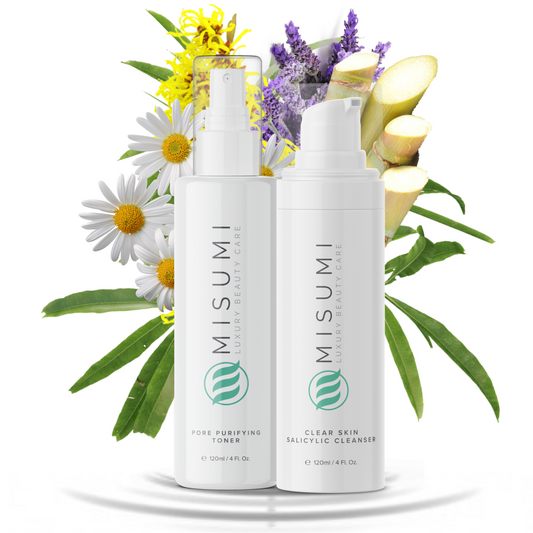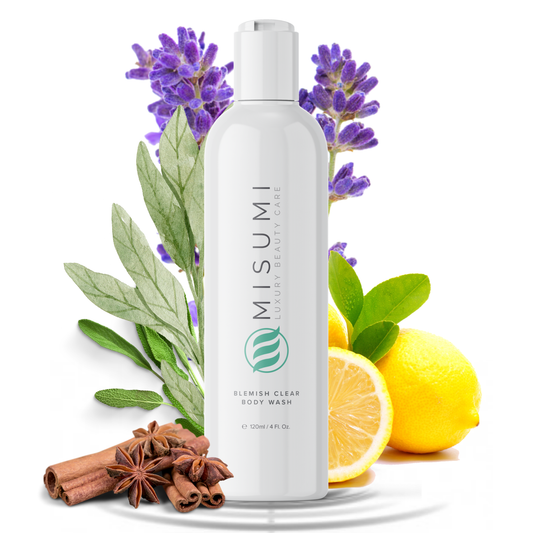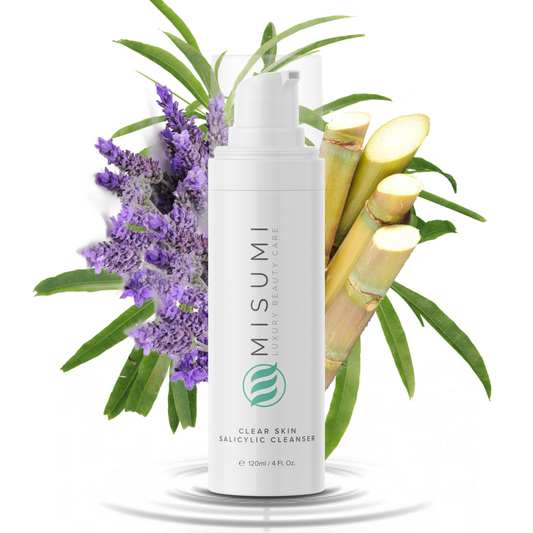Rumour has it using toothpaste for acne is a great way to clear those pimples in just one night. But, should you listen to rumors? Sometimes persistent inflamed pimples can make us feel frustrated and embarrassed, especially if there’s a social occasion you need to attend to.
I know the struggle - you probably tried every tip and trick there is, or maybe even anti-acne products like accutane, benzoyl peroxide, and salicylic acid - and nothing worked.
Can’t the pimples just go away?

Unfortunately, no, they can’t. And, if you are thinking “what’s the harm in trying”, let me tell you, applying abrasive products not meant for the skin can sometimes make things worse.
Many websites recommend toothpaste on acne as a fast way to dry out pimples and some bloggers swear by it, so what’s the deal with that?
It’s a two-way street - on one hand the formula and composition of toothpaste can help dry out pimples fast and reduce redness, but on the other hand, it can make the skin even more acne-prone and susceptible to other skin conditions.
Let’s try to break it all down and help you understand better: is toothpaste bad for acne, if yes, why and in which cases?
Either way, you don’t have to worry about it.. Even if you decide toothpaste is just not worth it - we got you covered with some amazing alternatives that we describe below. And of course, we’ve already covered some of the best natural and homemade remedies for acne you can check out later.
What Is Toothpaste Made Of?

Okay, let’s start from the start.
Toothpaste is a form of dentifrice, or in other words, an agent used to maintain our oral hygiene - to clean and polish the teeth.
But, everyone knows that, right?
What you may not know is that toothpaste is considered a strong abrasive meant to remove dental plaque from the teeth. But abrasives as ingredients are just one part of the story - there are many more ingredients in toothpaste that are potentially harmful to the skin.
Toothpaste is derived from a variety of components. But, generally, most of them consist of 20%–42% water and three main ingredients - abrasives, fluoride, and detergents.
Abrasives

These ingredients form at least 50% of any conventional toothpaste. Abrasives are responsible for removing plaque and calculus from the teeth, and the most commonly used ones are aluminum hydroxide, calcium carbonate, various calcium hydrogen phosphates, and various silicas and zeolites. You can find out how abrasive your toothpaste is by looking at the RDA value, which can go from 0 to even 200 RDA. There are some dentists that don’t recommend using a toothpaste with an RDA value higher than 50 for daily use.
Now, imagine - if a toothpaste can be considered too strong and potentially damaging to our strong teeth, which are hard, calcified structures, what can this paste do to tissue as soft as our skin?
The good news is that the abrasives used in toothpaste are not toxic to the skin and because of their strong drying effect they can reduce the symptoms of inflammation. The tricky part is, being as strong and abrasive as they are, they can make the skin really dry which will most likely trigger the oil glands to produce more sebum and turn your skin into an even better environment for acne breakouts.
Fluorides

We can argue that fluoride is one of the most famous and controversial ingredients in toothpaste. It’s used to prevent cavities, control gingivitis, and reduce surface stains. But, being as controversial as it is, fluoride is frequently linked with a variety of health problems, including some skin conditions, like eczema and psoriasis.
The International Academy of Oral Medicine and Toxicology issued a paper in 2017 which associated acne and other dermatological conditions with fluoride exposure.
Whether leaving a layer of toothpaste on the skin for a couple of hours can really have such an effect on the skin or not, is questionable. But are you willing to take the risk and possibly irritate you already inflamed skin?
Surfactants

Surfactants, or in other words, detergents, are the ingredients which improve the cleansing power of the toothpaste. This is also the reason why they are found in other personal care products like shampoos.
How do they work?
Surfactants are oil loving substances - when placed on the skin they will draw out the oil and bond with it. When the surfactant is rinsed off with water, it will take the oil with it, and away from the skin.
The most commonly used surfactant in toothpastes is sodium lauryl sulfate. Like all detergent surfactants, sodium lauryl sulfate removes oils from the skin, but is considered strong and can cause skin and eye irritation. A study from 2006 found that applying a 2% sodium lauryl sulfate concentration on the face and leaving it for an hour can cause skin irritation in young adults.
Other ingredients, frequently found in toothpaste, are:
- antibacterial agents, such as triclosan;
- flavorants, such as peppermint and spearmint;
- remineralizers;
- other miscellaneous components, such as sugar alcohols.
How Can Toothpaste Affect The Skin And Help Acne

As you can see, because of the drying power of the abrasives, the cleansing power of the surfactants, and the antibacterial powers of triclosan, toothpaste can effectively handle inflamed pimples given a short time frame. They can dry off the affected area, kill the bacteria causing the inflammation, and remove excess oil and dirt from the pores.
But, what people see, and what people believe is not a true representative of what is really going on under the surface.
So stay with me here.
Did you know that triclosan, an active antibacterial agent in many kinds of toothpaste, is associated with hormonal modification and resistance to antibiotics, which led the FDA to issue a final rule determining that triclosan is not generally recognized as safe and effective for use in certain over-the-counter (OTC) health care products? Because of this information, today you can find toothpaste without triclosan, which is good, but the antibacterial properties that might have helped kill the acne-causing bacteria are also gone.

Aside from the potentially harmful chemicals found in toothpaste, the strong drying effects can make the skin more acne-prone and cause even more acne breakouts.
People with sensitive skin should be even more careful because when toothpaste is used for acne it can easily lead to irritation, redness, and even a rash.
Last but not least, it’s worth noting that there are no ingredients in toothpaste which can make it more effective than conventional treatments. We can argue to a point, that using toothpaste for acne might be better than not doing anything. But then, in a sea of natural home remedies, medications, and other effective treatments for even the most severe of acne conditions and scarring, why choose toothpaste?
The Side-Effects Of Using Toothpaste On The Skin

Here and there, we’ve covered some of the potential side-effects when using toothpaste for acne, but here is a list of the things you should have in mind.
Skin Irritations
Because toothpaste is not meant for the skin, ingredients like fluoride and methanol, among others, over-dry the skin. You may believe that it dries out the pimple, but what really happens is irritation, redness, and peeling.
Pigmentation Problems
Some people over the internet have reported that they’ve noticed spots and discoloration of the skin after applying the toothpaste on acne-affected areas. Dermatologists explain this effect as a possibility because some people’s skin contains more melanin than others, and melanin is reactive to irritants, hence the dark pigmentation.

Burning The Skin
Over-drying and even burning can occur on the skin from applying it to acne-affected areas. If you have already tried to apply toothpaste on the face you may have noticed a burning sensation - which should always be a warning sign to take off the paste and stop damaging the skin. It’s true that blemishes won’t be visible on irritated and red skin, but does that really counts as helpful?
Over-drying The Skin
As mentioned earlier, one of the most likely scenario to happen, when applying toothpaste for acne, is drying out the skin to a point where your oil glands will start to produce a lot more sebum in order to compensate. Ironically, this can cause more pimples to surface on your skin.
Before You Try The Toothpaste

If you came here, already decided and we didn’t change your mind, here are the things you should consider before acting upon this idea.
Explore Other Alternatives
Let’s give it another try to drive you away from the toothpaste. I suspect you are going for something accessible and convenient, cheap, and delivering fast results. So, why not try something along those lines, but safer? Word on the street is hydrogen peroxide is an effective anti-acne agent. On top of this list, you can also find baking soda, banana peels, aspirin, tea tree oil, and sea salt. Before trying toothpaste for acne, try some of these.
Make Sure You Choose The Right Toothpaste For Safest Use
General advice would be to stay away from a whitening toothpaste and choose one that is plain white. Why?
Whitening toothpaste contains strong bleaching agents which can actually contribute to skin discoloration and burn your skin. This is especially important for people with a darker skin tone. Their skin has more melanin which can easily react with the toothpaste and lead to spots, uneven tone, and blemishes.

Choose white because the “good” ingredients, which actually affect the pimple and dry it off are contained in the white part of the toothpaste. These ingredients include baking soda, hydrogen peroxide, and triclosan.
Clear or gel toothpaste use a different formula, and might be useless against pimples. So, again stick to a traditional white one.
Another piece of advice is to be careful and read the ingredient label. Find a toothpaste that contains little to no fluoride, although that might be a hard task since fluoride is added to over 95% of toothpaste in the USA. Go for organic - which might be your best and safest option. Organic toothpaste contains only natural ingredients, but still has the ones necessary to dry out pimples.
How To Apply Toothpaste On Pimples

To avoid more complications make sure you are doing things right.
First, wash your face. This is implied with every face pack you might use at home, but it’s a good idea to remind you again. This is important as there will be no excess dirt, dermis, and oil on the skin that might block the ingredient from reaching the affected skin layers. You can use only warm water and a clean towel.
Second, clean your hands as well and apply a little bit of toothpaste on the tip of your finger. Make sure you apply only a small amount directly onto the pimple. Avoid touching the surrounding skin with the toothpaste. This way you will avoid causing irritation and redness to the healthy skin tissue.
Third, decide how long you want to leave the toothpaste. Generally, the advice is to leave it on for at least an hour or two, or even overnight. But, this might not be good for you. The best thing you can do is listen to your skin. Leave the toothpaste for 15 minutes and see how you will feel. If it’s comfortable you can leave it longer. If at any time you start to feel a burning sensation, wash it off with lukewarm water!
The final step is to wash your face and remove any toothpaste residue. Use warm water and then pat your face dry with a soft and clean towel. Moisturize your face to help counteract the drying effects of the toothpaste and make sure your skin doesn’t become too dry.
Don’t repeat too often and never use this method as a daily routine.

The Bottom Line
All things considered, we now know why this old wive’s tale has gained such popularity among acne treatments and remedies. Toothpaste contains a number of ingredients that can dry out pimples and reduce the symptoms of inflammation. That being said, toothpaste is filled with dangerous chemicals and can dry out and burn the skin, as well as cause problems with discoloration.
Does this short-term benefit outweigh the long list of potential and scary side-effects? At the end of the day, it’s your skin - so we’ll leave you to decide. Make sure you explore other options, read all the information provided in this text and find out everything there is about acne before taking action. Instead of focusing on fast and short-lived solutions, you might find something that will help you get rid of acne for good!
And, if you are going to use toothpaste for acne problems, make sure you choose the right one.







